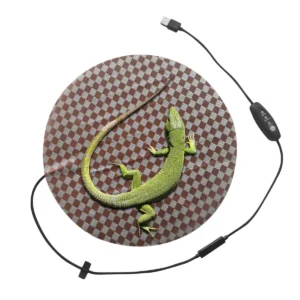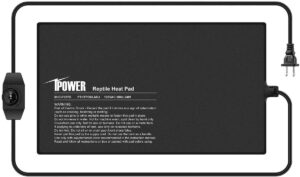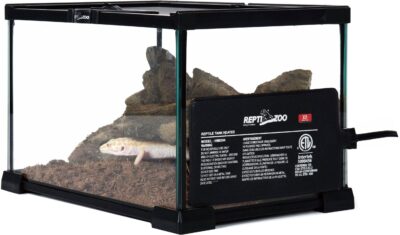Reptile enthusiasts understand the critical importance of providing optimal environments for their scaly companions, and one essential component in creating such environments is the reptile heating mat. Designed specifically to meet the unique reptile heating mat, these mats play a vital role in regulating temperature levels within reptile habitats.
Whether for snakes, lizards, or turtles, a reliable heating mat ensures that these cold-blooded creatures can thrive in captivity by mimicking the warmth they would experience in their natural habitats. Let’s delve deeper into the functionality, benefits, and considerations surrounding reptile heating mats.
Top 10 Reptile heating mat
1. BN-LINK Reptile Heating Pad Electric Indoor Und
- GREAT UTILITY: The BN-LINK Heating Pad for Reptiles is great for keeping your reptile...
- ENERGY EFFICIENT AND SPACE-SAVING: The BN-LINK Heating Pad is both compact and packs...
- EASY SETUP: It is suitable for any glass terrarium and all you gotta do is pull it...
2. Reptile Heating Mat
- SAFE & BALANCED HEATING - FIPASEN reptile heating pad is a safe and balanced...
- CONVENIENT TO USE - FIPASEN reptile heating mat can be installed on the bottom, or...
- SLOW HEATING FOR OVERHEAT PROTECT - FIPASEN reptile heat mat slow heating was...
3. Tikaton Reptile Heat Pad
- UPGRADED DESIGN: Temperature can be adjusted manually. POWERFUL FUNCTION: Helps...
- Durable material: made of high quality PVC material, its soft surface can be flexible...
- ENERGY-SAVING: This heater uses a solid state nichrome heating element Which only use...
4. Aiicioo Under Tank Heater Thermostat
- COMBO SET - Packed with digital thermostat and under tank heater. Reptile under tank...
- UPGRADED VERSION - Upgraded adhesive material of under tank heat pad is more solid...
- MOUNTING - Reptile heat mat with thermostat optional mounting on bottom or side of...
5. iPower Reptile Heat Pad
- Variety of uses: perfect for reptile, lizard, amphibian, small animal or plant...
- Energy efficient: new PTC heating material and insulation increases overall heat...
- 3M adhesive Paper: 3M adhesive Paper of the heat Mat provides a strong grip to the...
6. KABASI Reptile Heating Pad
- SAFE AND THERMOSTATIC : Closed circuit, anti-leakage, balanced temperature...
- WATERPROOF AND DAMP PROOF : Water proof and moisture proof designed, can be wiped...
- ENERGY SAVING : The temperature is uniform, ultra-low consumption, energy-saving,...
7. VIVOSUN Reptile Heating Pad
- Durable Materials: Made of high-quality materials that it meets UL certification;...
- Intelligent Constant Temperature: This reptile heat pad can get well about...
- Easy to Set: Bottom mounting and the side mounting of the Reptile Heat Pad are also...
8. KABASI Reptile Heating Pad
- SAFE AND THERMOSTATIC : Closed circuit, anti-leakage, balanced temperature...
- WATERPROOF AND DAMP PROOF : Water proof and moisture proof designed, can be wiped...
- ENERGY SAVING : The temperature is uniform, ultra-low consumption, energy-saving,...
9. Zilla Terrarium Heat Mats Black Large
- Ideal heat source for desert and tropical reptiles
- Carbon fiber radiates uniform heating without hot spots and is energy-efficient...
- Easy-to-use adhesive mounting either underneath or on the side of the terrarium
10. Hamiledyi 14W Reptile Heating Pad
- Premium Material --- Made of good quality Nichrome heating wire and good quality PVC...
- Constant Temperature safety---Safe and balanced temperature distribution, providing...
- Easy to Use---The heating pad is easy to clean and wipe with a damp towel. Easy to...
Importance of proper heating for reptiles

Proper heating is paramount for the well-being and health of reptiles kept in captivity. Unlike mammals, reptiles are ectothermic, meaning they rely on external heat sources to regulate their body temperature. Failure to provide adequate heating can lead to a host of problems, including metabolic issues, impaired digestion, weakened immune systems, and even death.
In their natural habitats, reptiles have access to various microclimates, allowing them to move between warmer and cooler areas as needed. However, in captivity, it’s the responsibility of the keeper to create and maintain these temperature gradients within the enclosure. This is where heating devices, such as heating mats, play a crucial role.
Reptile heating mats provide a localized heat source that allows reptiles to thermoregulate effectively. By mimicking the warmth of the sun on a reptile’s basking spot, these mats enable reptiles to engage in natural behaviors like basking, digestion, and thermoregulation. Additionally, proper heating supports essential physiological processes such as metabolism, digestion, and immune function.
Furthermore, maintaining optimal temperatures is especially critical during certain stages of a reptile’s life, such as during breeding, gestation, or shedding. In these instances, precise control over temperatures can significantly impact the reptile’s health and reproductive success.
In conclusion, providing proper heating for reptiles is not just a matter of comfort; it’s a fundamental aspect of their care that directly influences their health, behavior, and overall quality of life in captivity.
What are reptile heating mats?
Reptile heating mats, also known as reptile heat pads or reptile under tank heaters (UTH), are specialized heating devices designed to provide supplemental heat for reptiles housed in terrariums or vivariums. These mats are typically thin, flexible pads that are placed beneath the enclosure’s substrate or on the bottom of the tank.
The purpose of reptile heating mats is to create a warm spot within the enclosure, allowing reptiles to regulate their body temperature by moving to or away from the heat source as needed. Reptiles are ectothermic, meaning they rely on external heat sources to regulate their body temperature and metabolism.
By providing a heating mat, reptile owners can create a thermal gradient within the enclosure, with one side of the tank being warmer than the other. This allows the reptile to thermoregulate by moving between warmer and cooler areas as necessary to maintain optimal body temperature.
It’s essential to use a thermostat with reptile heating mats to regulate the temperature and prevent overheating. Additionally, owners should carefully monitor temperatures within the enclosure to ensure they align with the specific needs of the reptile species being kept.
How do reptile heating mats work?
Reptile heating mats work by generating heat through electrical resistance. They are equipped with heating elements encased in a durable, waterproof material that can withstand the conditions of a reptile enclosure.
When plugged into a power source, the heating mat converts electrical energy into heat. This heat is then radiated upwards through the bottom of the terrarium or vivarium, providing a warm surface for the reptile to bask on.
The temperature of the heating mat can be controlled using a thermostat, which regulates the amount of power supplied to the heating element. This allows owners to maintain a consistent and safe temperature range within the enclosure.
Reptile heating mats are designed to mimic the warmth of the sun, which reptiles rely on to regulate their body temperature in their natural habitats. By creating a thermal gradient within the enclosure, heating mats enable reptiles to thermoregulate effectively, moving between warmer and cooler areas as needed to maintain optimal body temperature and overall health.
Benefits of Reptile Heating Mats

Reptile heating mats offer several benefits for reptiles kept in captivity:
- Thermoregulation: Reptiles are ectothermic, meaning they rely on external heat sources to regulate their body temperature. Heating mats provide a localized heat source that allows reptiles to thermoregulate by moving between warmer and cooler areas within their enclosure.
- Digestion: Maintaining an appropriate body temperature is crucial for reptiles to properly digest their food. Heating mats ensure that reptiles can adequately digest their meals by providing the necessary warmth.
- Behavioral Health: Reptiles are more active and exhibit natural behaviors, such as basking and exploring, when provided with suitable thermal gradients. Heating mats encourage these behaviors by creating warm spots for basking and cooler areas for rest.
- Comfort: Just like humans, reptiles enjoy warmth and comfort. Heating mats simulate the warmth of the sun, creating a cozy environment for reptiles to thrive in captivity.
- Health Maintenance: Proper thermal gradients provided by heating mats help prevent health issues such as respiratory infections and metabolic disorders, which can arise from inadequate temperature regulation.
- Safety: Reptile heating mats are designed to provide a consistent and controlled heat source, reducing the risk of burns or overheating compared to other heating methods like heat lamps.
- Energy Efficiency: Heating mats are often more energy-efficient than heat lamps or ceramic heat emitters, as they only heat the surface area they cover rather than the entire enclosure.
- Versatility: Heating mats come in various sizes and wattages, making them suitable for different types of reptile enclosures, from small terrariums to large vivariums.
Overall, heating mats are an essential tool for reptile keepers to create a comfortable and healthy environment for their cold-blooded companions. However, it’s crucial to monitor temperatures closely to ensure they remain within the optimal range for the species being housed.
Choosing the Right Reptile Heating Mat
Choosing the right reptile heating mat involves considering several factors to ensure it meets the specific needs of your reptile and enclosure:
- Size and Wattage: Select a heating mat that matches the size of your reptile enclosure. It should cover approximately one-third to one-half of the enclosure’s floor space. Additionally, consider the wattage of the heating mat to ensure it provides adequate heat for the size of the enclosure without overheating.
- Temperature Control: Look for heating mats with adjustable temperature controls or thermostats. This allows you to regulate the temperature of the mat to create the appropriate thermal gradient within the enclosure.
- Safety Features: Choose a heating mat that includes safety features such as built-in overheating protection or a waterproof design. These features help prevent accidents and ensure the safety of your reptile.
- Durability and Quality: Invest in a high-quality heating mat from a reputable manufacturer to ensure durability and reliability. A well-made heating mat will last longer and provide consistent heat for your reptile.
- Type of Reptile: Consider the specific temperature requirements of your reptile species when choosing a heating mat. Some reptiles, such as desert species, may require higher temperatures, while others, like tropical species, may prefer lower temperatures.
- Installation: Choose a heating mat that is easy to install and fits securely within your reptile enclosure. Some heating mats come with adhesive backing or mounting hardware for easy installation.
- Budget: Consider your budget when choosing a heating mat, but prioritize quality and safety over price. Investing in a higher-quality heating mat may save you money in the long run by avoiding the need for frequent replacements.
- Reviews and Recommendations: Read reviews from other reptile keepers and seek recommendations from experienced hobbyists or veterinarians to help you choose the best heating mat for your needs.
By considering these factors, you can select a reptile heating mat that provides the right amount of heat, safety, and durability for your reptile enclosure, ensuring the comfort and well-being of your pet.
Installation and Maintenance
Installation and maintenance are crucial aspects of ensuring the effectiveness and safety of reptile heating mats. Here’s a guide for both:
Installation:
- Clean the Enclosure: Before installing the heating mat, thoroughly clean the enclosure to remove any debris or substrate that may interfere with its operation.
- Positioning: Place the heating mat on the outside bottom of the reptile enclosure, underneath one side or a portion of the enclosure. This creates a thermal gradient, allowing your reptile to move between warmer and cooler areas as needed.
- Adhesion: If the heating mat has adhesive backing, carefully remove the protective covering and press the mat firmly onto the bottom of the enclosure. Ensure it is securely attached and does not have any air bubbles or wrinkles.
- Thermostat Placement: If your heating mat includes a thermostat, place the temperature probe inside the enclosure near the heating mat. This allows the thermostat to accurately regulate the temperature.
- Temperature Adjustment: Set the temperature of the heating mat according to the specific requirements of your reptile species. Monitor the temperature closely using a thermometer to ensure it remains within the optimal range.
- Safety Precautions: Ensure that the heating mat is not in direct contact with any flammable materials or substrates to prevent the risk of fire. Additionally, regularly check the heating mat and its power cord for any signs of damage or wear.
Maintenance:
- Regular Cleaning: Periodically remove the heating mat from the enclosure and clean its surface with a damp cloth to remove any dust, dirt, or debris. This helps maintain its effectiveness and prolong its lifespan.
- Temperature Monitoring: Continuously monitor the temperature of the heating mat using a reliable thermometer. Check the temperature at various points within the enclosure to ensure an appropriate thermal gradient is maintained.
- Inspect for Damage: Regularly inspect the heating mat and its power cord for any signs of damage, wear, or malfunction. If you notice any frayed wires, cracks, or other issues, discontinue use immediately and replace the heating mat.
- Adjustment: Periodically review and adjust the temperature settings of the heating mat as needed, especially during seasonal changes or fluctuations in ambient room temperature.
- Replace When Necessary: Heating mats have a lifespan, and they may become less effective over time. If you notice any decline in performance or if the heating mat shows signs of wear, consider replacing it with a new one.
By following these installation and maintenance guidelines, you can ensure that your reptile heating mat operates safely and effectively, providing the necessary warmth for your reptile’s health and well-being.
Best Brands of heating mat for reptiles

Several reputable brands produce high-quality heating mats for reptiles. Here are some of the best brands known for their reliability and effectiveness:
- Zoo Med: Zoo Med is a well-known manufacturer of reptile products, including heating mats. Their heating mats come in various sizes and wattages, with options for both terrestrial and arboreal reptiles.
- Fluker’s: Fluker’s offers a range of heating mats designed to meet the needs of different reptile species. Their heating mats are durable, easy to install, and come with safety features such as built-in thermostats.
- Exo Terra: Exo Terra is another popular brand among reptile keepers, known for its high-quality reptile supplies. Their heating mats are designed to provide uniform heat distribution and come in a variety of sizes to fit different enclosure types.
- iPower: iPower specializes in reptile heating products, including heating mats, pads, and thermostats. Their heating mats are known for their reliability and affordability, making them a popular choice among reptile keepers.
- Ultratherm: Ultratherm heating mats are known for their high-quality construction and consistent heat output. They are designed to be durable and long-lasting, providing a reliable heat source for reptiles.
- ReptiTherm: ReptiTherm heating mats are made by Hagen, a trusted manufacturer of pet supplies. Their heating mats are designed to be energy-efficient and come with adjustable temperature controls for precise heat regulation.
- VIVOSUN: While primarily known for horticultural products, VIVOSUN also produces heating mats suitable for reptiles. Their heating mats are durable, waterproof, and come with built-in thermostats for temperature control.
When selecting a heating mat, consider factors such as size, wattage, temperature control options, and safety features to ensure it meets the specific needs of your reptile and enclosure. Additionally, reading reviews from other reptile keepers can provide valuable insights into the performance and reliability of different brands.
How to Determine the Correct Temperature
Determining the correct temperature for your reptile enclosure is crucial for the health and well-being of your pet. Here’s how you can determine and maintain the correct temperature:
- Research Your Reptile’s Species: Different reptile species have specific temperature requirements based on their natural habitat and physiology. Research your reptile species to understand its temperature preferences, including the optimal temperature range and any temperature gradients it may require.
- Use a Thermometer: Invest in a reliable thermometer to accurately measure the temperature within your reptile enclosure. Place the thermometer at different points within the enclosure to ensure an accurate representation of the temperature gradient.
- Monitor Surface and Ambient Temperatures: Measure both the surface temperature of the heating mat and the ambient temperature within the enclosure. The surface temperature of the heating mat should be within the range recommended for your reptile species, while the ambient temperature should create a suitable thermal gradient.
- Observe Reptile Behavior: Monitor your reptile’s behavior to determine if the temperature within the enclosure is suitable. Signs of an inadequate temperature include excessive basking, seeking cooler areas, or lack of activity. Adjust the temperature settings accordingly based on your observations.
- Adjust Heating Mat Settings: If your heating mat has adjustable temperature settings, use them to fine-tune the temperature within the enclosure. Start with a lower setting and gradually increase it until you achieve the desired temperature gradient.
- Consider Environmental Factors: Factors such as room temperature, humidity levels, and airflow can affect the temperature within the enclosure. Take these factors into account when determining the correct temperature and make adjustments as needed to maintain a stable environment.
- Seek Professional Advice: If you’re unsure about the correct temperature requirements for your reptile species or if you encounter difficulties in maintaining the temperature within the enclosure, seek advice from experienced reptile keepers or a reptile veterinarian.
By carefully monitoring and adjusting the temperature within your reptile enclosure, you can ensure that your pet remains healthy and comfortable in its captive environment. Regular temperature checks and adjustments are essential to maintaining the optimal conditions for your reptile’s well-being.
Conclusion
Reptile heating mats offer a reliable and effective solution for providing the necessary warmth and thermal gradients within reptile enclosures. With features such as adjustable temperature controls, safety mechanisms, and various sizes to suit different enclosure setups, reptile heating mats ensure the comfort and well-being of your cold-blooded companions.
By investing in a quality reptile heating mat, you can create a safe and comfortable environment that mimics the natural habitat of your reptile, promoting their health and natural behaviors.










